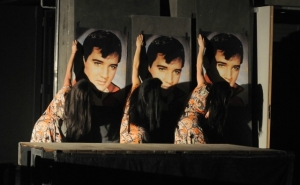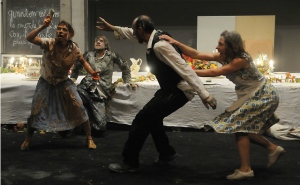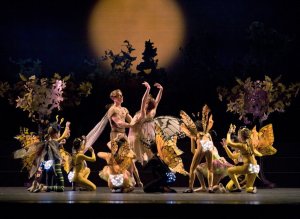Any time you see seeming polarities, look for the greater truth that contains them both. – David Bohm

Image of Compagnie Maguy Marin performance of “Salves” courtesy of Canada’s National Art Centre web site
This past weekend I had the pleasure of attending two very different dance productions. On Friday night was a local-premier production by a Toulouse, France-based dance company, Compagnie Maguy Marin titled “Salves”. This troupe was brought to the US by White Bird, a local dance organization. On Sunday I went to a presentation by the Oregon Ballet Theater, the first half was “Por Vos Muero”, a contemporary ballet choreographed in the last 20 years, and the second half was Christopher Stowell’s “A Midsummer Night’s Dream”. I enjoyed both fully, while the audience reactions were clearly different. Both were lines of body poetry, both were dance and both were successful.
Settling into the theater on Friday night with my husband and another couple I was thrilled to be seeing a contemporary dance piece. The last I was able to savor was a 3D documentary by Wim Wenders and Werner Herzog about Pina Bausch – an extraordinary dancer and choreographer. Dance has been a big part of my life; I danced for 13 years and have since danced unofficially and often after dinner and/or with my children.
The dance began with the lights on over the audience. It’s recent that we close the lights on the audience and keep the stage lit up. With the invention of light in the 19th century came the darkening of the audience and therefore marked the end of audience participation in theater. The gesture of leaving the audience lights on was a gesture of participation, of input. Engagement is a theme in the visual arts now, as it must be in the dance arts too. They picked regularly-dressed dancers from the audience, and convened on stage and pulled an invisible thread together. The thread supposedly tied them together, and made the connections they were seeking.
The light turned off and for the following 45 minutes or so was a tumultuous and fractured rhythm of individuals, voices, and objects. Sound gave way to light that gave way to rush and rally. The entire production was peppered with people falling, plates breaking and people getting lost and found. The entire time I was watching I thought it was perfect – this is how we participate often in life and with our memory – we turn things on and off, we connect and disconnect, and we do it so fast that we barely have time to make any meaning of it.
The piece culminated with a huge banquet the dancers prepared. They ended up getting in a colorful and violent food fight which was primarily quelled by the entry of a remote control helicopter carrying what looked like the pope or Jesus. As soon as the helicopter left the stage the dancers returned to the mayhem, and the terror of their relations.

Image of Compagnie Maguy Marin performance of “Salves” courtesy of Canada’s National Art Centre web site
Sounds strange, but really this was the perfect analogy to the expectations and trials we go through with those connections closest to us. We seek connections in life, this imaginary thread, and when we finally connect (e.g. Thanksgiving dinner), we have battles and scratch at wounds instead of really being grateful for the love, support and explicit connection of those around us.
I absolutely loved the work. As soon as the house lights came up, we stood up and I heard my friend apologize profusely for taking us to the show, and her husband chimed in that he had just about had an anxiety attack. They were mortified and absolutely hated it. She was pregnant and even suggested her unborn baby may have been traumatized by this dance. Wow. I rest assured her that the baby would be fine, I had taken my first child in utero to dance clubs in Vegas at 7 months and she is just fine. I tried to defend the work by reminding them of the origin of tragedy – the Greeks invented it so they could purge themselves of those emotions and feel the others in their place. My convincing didn’t seem to work, they stayed strong with their opinions on the dance. They were supported by mutterings of disgust by fellow audience members leaving the theater.
I spent the rest of the evening wondering how this could have been so perfect in my eyes, and utterly lost and misunderstood by so many. My husband said it was because I had been used to watching performance art, had a respect for this and that others have not yet. I disagreed, as I have seen performance pieces that really bother me too – it’s not all good stuff! (Jay-Z singing “Picasso Baby” in a gallery for six hours with a delirious flood of other artists and fans – not good). I think it comes down to cadence and patience. I like slowing things down, and I absolutely love the pushing of the boundaries on feelings. How you can be made to feel so strongly with only light, movement and gesture is fascinating.
Two days later, I settle into my seat with my daughter this time ready to watch the Oregon Ballet Theater production. This too will be a premier, this “Por Vos Mueros”. Before the lights go down on the audience, a kind older woman asked us if we come often to the ballet. I said yes, I had been taking my kids since they were three. I also inquired if she supports other dance companies in the city, and she named a few. She mentioned White Bird, but that she went to the production on Friday night, and “Hated it!! We left halfway in!” I listened to her complaints, but there was nothing of substance, just a mélange of the words “awful, hate and terrible”. When she was finished, I told her I adored it. Then the lights went down.
The show was as anticipated – beautiful-half naked bodies intertwining in a pretty sexual way, a sexy voice of what sounded like Javier Bardem speaking to the dancers as they performed the classical ballet inspired piece. Music was from the Renaissance period, and the dancers had matching outfits, except the ladies had full-length gowns, while the boys had Renaissance tops with tap pants to show off their muscles. Throughout this first piece there was a lot of “ooh-ing and ahh-ing” from my neighbor.
The second half was a classic story ballet complete with beautiful set and sumptuous costumes. It was a slight twist on the Midsummer Night’s Dream – same story line, except there was a “modern” wedding scene at the beginning, with a troupe of bartenders cutting into the dream sequences throughout the ballet.
The sport was the marvel here, the other parts are vanity – which I am no stranger too, but it certainly doesn’t hit the bones like the Maguy Marin piece did. It reminded me I was not in dance shape anymore, and was excited to see the athleticism and skill from the young dancers. When driving home I asked my daughter if that made her feel like dancing? She said “No, it made me feel like dreaming”.
So there you have it, one was entertaining and lifted the spirits to a dream state, and one was a mirror, a mirror reflecting a world of individuals trying desperately to make sense of fracture and wholeness.

Image courtesy Blaine Truitt Covert and the Oregonian web site, OBT’s production of Christopher Stowell’s “A Midsummer Night’s Dream”
As Pina Bausch once told her dancers, and is good advice for anyone and any artist: “Dance, dance otherwise we are lost.”
Tagged: Christopher Stowell, Compagnie Maguy Marin, Contemporary Dance, Dance, dancers, David Bohm, Jay-Z, Maguy Marin, Midsummer Night's Dream, Oregon Ballet Theater, performance, performance art, Perfromance Art, Picasso Baby, Pina, Pina Bausch, Por Vos Mueros, Salves, Werner Herzog, White Bird, Wim Wenders
0 Comments
Would you like to share your thoughts?